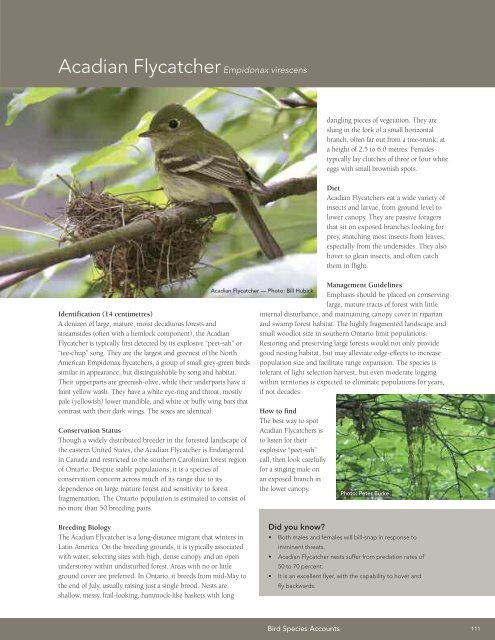A land manager's guide to conserving habitat for forest birds in ...
A land manager's guide to conserving habitat for forest birds in ...
A land manager's guide to conserving habitat for forest birds in ...
Create successful ePaper yourself
Turn your PDF publications into a flip-book with our unique Google optimized e-Paper software.
Acadian Flycatcher Empidonax virescens<br />
dangl<strong>in</strong>g pieces of vegetation. They are<br />
slung <strong>in</strong> the <strong>for</strong>k of a small horizontal<br />
branch, often far out from a tree-trunk, at<br />
a height of 2.5 <strong>to</strong> 6.0 metres. Females<br />
typically lay clutches of three or four white<br />
eggs with small brownish spots.<br />
Identification (14 centimetres)<br />
A denizen of large, mature, moist deciduous <strong>for</strong>ests and<br />
streamsides (often with a hemlock component), the Acadian<br />
Flycatcher is typically first detected by its explosive “peet-sah” or<br />
“tee-chup” song. They are the largest and greenest of the North<br />
American Empidonax flycatchers, a group of small grey-green <strong>birds</strong><br />
similar <strong>in</strong> appearance, but dist<strong>in</strong>guishable by song and <strong>habitat</strong>.<br />
Their upperparts are greenish-olive, while their underparts have a<br />
fa<strong>in</strong>t yellow wash. They have a white eye-r<strong>in</strong>g and throat, mostly<br />
pale (yellowish) lower mandible, and white or buffy w<strong>in</strong>g bars that<br />
contrast with their dark w<strong>in</strong>gs. The sexes are identical.<br />
Conservation Status<br />
Though a widely distributed breeder <strong>in</strong> the <strong>for</strong>ested <strong>land</strong>scape of<br />
the eastern United States, the Acadian Flycatcher is Endangered<br />
<strong>in</strong> Canada and restricted <strong>to</strong> the southern Carol<strong>in</strong>ian <strong>for</strong>est region<br />
of Ontario. Despite stable populations, it is a species of<br />
conservation concern across much of its range due <strong>to</strong> its<br />
dependence on large mature <strong>for</strong>est and sensitivity <strong>to</strong> <strong>for</strong>est<br />
fragmentation. The Ontario population is estimated <strong>to</strong> consist of<br />
no more than 50 breed<strong>in</strong>g pairs.<br />
Diet<br />
Acadian Flycatchers eat a wide variety of<br />
<strong>in</strong>sects and larvae, from ground level <strong>to</strong><br />
lower canopy. They are passive <strong>for</strong>agers<br />
that sit on exposed branches look<strong>in</strong>g <strong>for</strong><br />
prey, snatch<strong>in</strong>g most <strong>in</strong>sects from leaves,<br />
especially from the undersides. They also<br />
hover <strong>to</strong> glean <strong>in</strong>sects, and often catch<br />
them <strong>in</strong> flight.<br />
Management Guidel<strong>in</strong>es<br />
Emphasis should be placed on <strong>conserv<strong>in</strong>g</strong><br />
large, mature tracts of <strong>for</strong>est with little<br />
<strong>in</strong>ternal disturbance, and ma<strong>in</strong>ta<strong>in</strong><strong>in</strong>g canopy cover <strong>in</strong> riparian<br />
and swamp <strong>for</strong>est <strong>habitat</strong>. The highly fragmented <strong>land</strong>scape and<br />
small woodlot size <strong>in</strong> southern Ontario limit populations.<br />
Res<strong>to</strong>r<strong>in</strong>g and preserv<strong>in</strong>g large <strong>for</strong>ests would not only provide<br />
good nest<strong>in</strong>g <strong>habitat</strong>, but may alleviate edge-effects <strong>to</strong> <strong>in</strong>crease<br />
population size and facilitate range expansion. The species is<br />
<strong>to</strong>lerant of light selection harvest, but even moderate logg<strong>in</strong>g<br />
with<strong>in</strong> terri<strong>to</strong>ries is expected <strong>to</strong> elim<strong>in</strong>ate populations <strong>for</strong> years,<br />
if not decades.<br />
Acadian Flycatcher — Pho<strong>to</strong>: Bill Hubick<br />
How <strong>to</strong> f<strong>in</strong>d<br />
The best way <strong>to</strong> spot<br />
Acadian Flycatchers is<br />
<strong>to</strong> listen <strong>for</strong> their<br />
explosive “peet-sah”<br />
call, then look carefully<br />
<strong>for</strong> a s<strong>in</strong>g<strong>in</strong>g male on<br />
an exposed branch <strong>in</strong><br />
the lower canopy.<br />
Pho<strong>to</strong>: Peter Burke<br />
Breed<strong>in</strong>g Biology<br />
The Acadian Flycatcher is a long-distance migrant that w<strong>in</strong>ters <strong>in</strong><br />
Lat<strong>in</strong> America. On the breed<strong>in</strong>g grounds, it is typically associated<br />
with water, select<strong>in</strong>g sites with high, dense canopy and an open<br />
unders<strong>to</strong>rey with<strong>in</strong> undisturbed <strong>for</strong>est. Areas with no or little<br />
ground cover are preferred. In Ontario, it breeds from mid-May <strong>to</strong><br />
the end of July, usually rais<strong>in</strong>g just a s<strong>in</strong>gle brood. Nests are<br />
shallow, messy, frail-look<strong>in</strong>g, hammock-like baskets with long<br />
Did you know?<br />
• Both males and females will bill-snap <strong>in</strong> response <strong>to</strong><br />
imm<strong>in</strong>ent threats.<br />
• Acadian Flycatcher nests suffer from predation rates of<br />
50 <strong>to</strong> 70 percent.<br />
• It is an excellent flyer, with the capability <strong>to</strong> hover and<br />
fly backwards.<br />
Bird Species Accounts 111

















